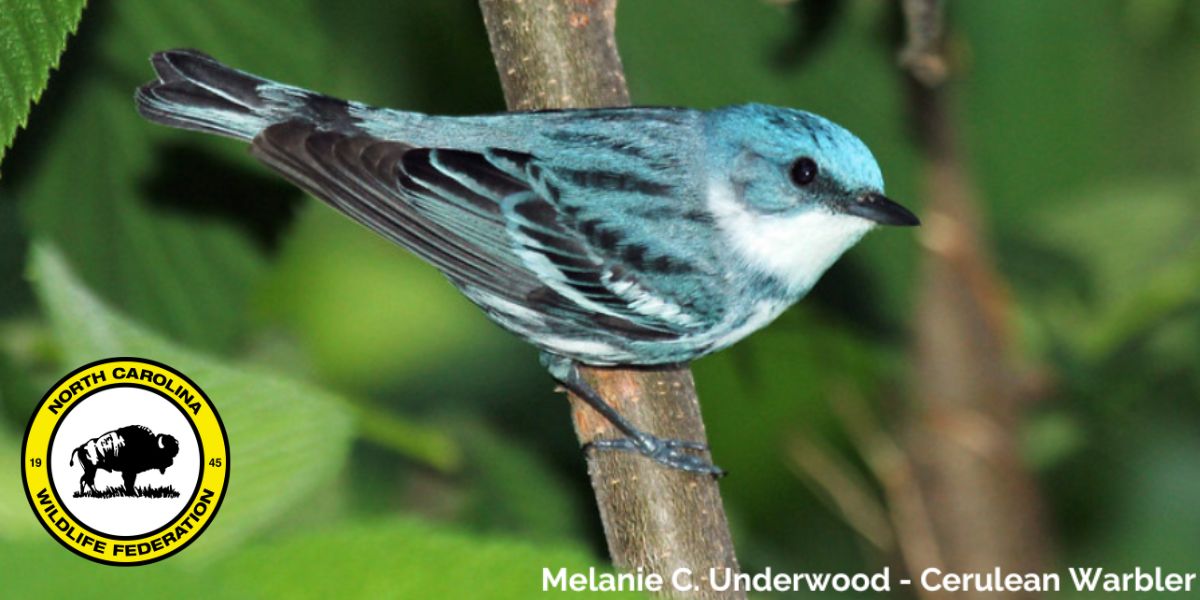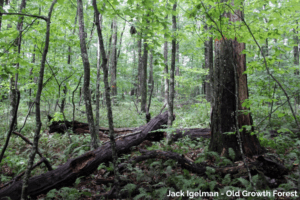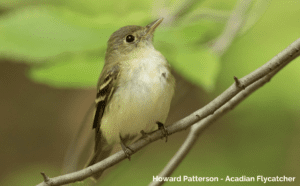Cerulean Warbler and Avian Diversity Study: An Opportunity for Volunteers to Engage in Community Science and Conservation

Southern Appalachian forests on a spring day are nothing short of magical. It’s an explosion of life and activity after the long doldrums of winter. Trees suddenly leaf out and wildflowers crane toward pockets of sunshine. Amphibians and reptiles take notice of the warmth as they emerge into view. Mammals search for food and mates. The forest is suddenly filled with a blast of colorful neotropical migratory songbirds that have traveled thousands of miles from their wintering grounds in Central and South America back to their breeding grounds in the Southeastern United States.
Unfortunately, many of these migratory bird species are in trouble. The cerulean warbler (Setophaga cerulea) for example is facing a 74% decline in the Appalachian Forest primarily due to habitat loss impacting their breeding grounds, stopover habitats, and wintering grounds. Ceruleans are brilliant skyblue songbirds that migrate over 2,500 miles between their breeding and wintering grounds. This species needs mature and old-growth deciduous forest in the eastern United States to maintain and grow its population. It’s important that we understand the relationship between ceruleans and old-growth forests in order to effectively protect this Species of Greatest Conservation Need (SGCN).
 In North Carolina, SGCN have been defined as species that are currently rare or have been designated as at-risk of extinction; those for which we have knowledge deficiencies; and those that have not received adequate conservation attention in the past. In addition, SGCN may also include those species for which we are unable to determine true status in the state, making them a priority for research due to knowledge gaps.
In North Carolina, SGCN have been defined as species that are currently rare or have been designated as at-risk of extinction; those for which we have knowledge deficiencies; and those that have not received adequate conservation attention in the past. In addition, SGCN may also include those species for which we are unable to determine true status in the state, making them a priority for research due to knowledge gaps.
Our national forests in North Carolina contain a significant proportion of the remaining old-growth forests in the Southern Appalachians, which total approximately only 4-5 percent of all public lands. The national forests of Western North Carolina are a biodiversity hotspot and provide critical habitat for cerulean warblers along with numerous other SGCN such as worm-eating warbler (Helmitheros vermivorum) and acadian flycatcher (Empidonax virescens).
This spring, the North Carolina Wildlife Federation is partnering with the National Parks Conservation Association, the Center  for Biological Diversity, Defenders of Wildlife, MountainTrue, and the N.C. Wildlife Resources Commission with support from the U.S. Forest Service to help with a cerulean warbler and avian diversity survey project focused on the last remaining patches of old-growth forests and maturing second-growth forests within the Craggy Mountains – Pisgah National Forest where presence of ceruleans and many other avian species is largely unknown. This project began in 2024 and will in subsequent years continue into public lands adjacent to the Blue Ridge Parkway and Appalachian Trail in North Carolina.
for Biological Diversity, Defenders of Wildlife, MountainTrue, and the N.C. Wildlife Resources Commission with support from the U.S. Forest Service to help with a cerulean warbler and avian diversity survey project focused on the last remaining patches of old-growth forests and maturing second-growth forests within the Craggy Mountains – Pisgah National Forest where presence of ceruleans and many other avian species is largely unknown. This project began in 2024 and will in subsequent years continue into public lands adjacent to the Blue Ridge Parkway and Appalachian Trail in North Carolina.
Our goal is to fill area-specific knowledge gaps to provide best available information for future decision making in forest management and conservation efforts. To achieve this goal, we are using acoustic recording units (ARUs). The units are mounted to trees within suitable habitat and automatically record songs at dawn and dusk everyday for weeks at a time. ARUs record everything and paint a picture of all the birds within these areas including species associated with similar habitats and in decline.
This project is especially important given the impact of Hurricane Helene on Pisgah National Forest. It’s hard to say to what degree cerulean warbler’s breeding habitat has been impacted but this project offers an incredibly valuable opportunity to analyze species population data before and after the storm.
Cerulean Warbler Avian Study – How You Can Help
 North Carolina Wildlife Federation is looking for volunteers to join us in the field. The Craggy Mountains are known for their rugged terrain, steep slopes and mature forests. Volunteers will be expected to hike 5 + miles off trail in sometimes physically challenging conditions to reach target sites and install ARUs. Volunteers will start with a team lead and training will be provided.
North Carolina Wildlife Federation is looking for volunteers to join us in the field. The Craggy Mountains are known for their rugged terrain, steep slopes and mature forests. Volunteers will be expected to hike 5 + miles off trail in sometimes physically challenging conditions to reach target sites and install ARUs. Volunteers will start with a team lead and training will be provided.
NCWF will be leading volunteers in the field on –
Thursday – May 1
Thursday – May 22
Thursday – May 29
Thursday – June 5
Thursday – June 19
We’ll start by 9AM and spend 6 to 7 hours in the field. Carpooling from the Asheville area will be available. More dates are available for volunteers who are not able to participate on the dates above. Please email Luke Bennett luke@ncwf.org if you are interested in volunteering and we’ll be in touch with more information – what to bring, where to meet, etc. See you out there!
Written by:

– Luke Bennett, NCWF Conservation Coordinator

